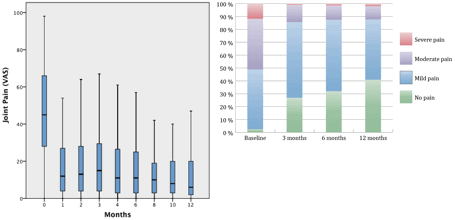Session Information
Date: Sunday, November 8, 2015
Title: ARHP I: Exemplary Abstracts
Session Type: ARHP Concurrent Abstract Session
Session Time: 2:30PM-4:00PM
Background/Purpose: Pain is the symptom people with rheumatoid arthritis (RA) have
prioritized highest for improvement [1]. Treating to target and aiming for remission in early RA may reduce
pain, but there is limited knowledge about the impact of pain in RA patients
classified using the 2010 ACR/EULAR criteria and treated according to modern
treatment strategies. The objective of this study was to explore and describe
changes in the degree of pain in early RA during the first year after starting
treatment with DMARDs.
Methods: Patients
from 11 rheumatology centers who fulfilled the 2010 ACR/EULAR classification
criteria for RA, with symptom duration (from first swollen joint) less than 2
years, and were DMARD naïve with indication for DMARD treatment, were followed
for 1 year. Treatment target was remission, and DMARD was prescribed according
to international recommendations. Pain was recorded on a Visual Analog Scale
(VAS 0-100 mm) at every visit, and grouped according to Jensen et al. [2] with cut points for no pain set at 0-4
mm, mild 5-44 mm, moderate 45-74 mm and severe pain 75-100 mm. Short Form 36
(SF-36) bodily pain was recorded, and transformed to a scale from 0-100, where
high score indicates low bodily pain.
Results: A
total of 205 early RA patients were included: 61.5% female, 82.4% ACPA positive,
mean (SD) age 52.2 (13.4) years. At initiation of DMARD treatment the mean
(SD) 44-swollen joint count was 10.2 (7.2), Ritchie Articular Index 8.14 (6.5),
ESR 24 (19) mm/hr and Patient Global Assessment 49 (24) mm. DAS was mean (SD) 3.4
(1.1): 20.1% were in low DAS, 47.1% in moderate DAS and 32.8% in high DAS. VAS pain
at baseline was median (IQR) 45 (27-68) mm, and decreased to 12 (4-27) mm after
1 month, and after 1 year to 6 (2-20) mm; see fig. 1A for details. Mean (SD) SF-36
bodily pain at baseline was 40 (21), and 73 (23) after 1 year. At baseline
less than 3% of patients reported no pain, after 3/6/12 months this proportion
increased to 27/32/41%, and after 12 months more than 87% of patients reported
either mild or no pain (fig. 1B).
Conclusion: In
this cohort of early DMARD-naïve RA patients treated according to modern
treatment strategies aiming for remission, there was a significant reduction of
pain after 1 month, and pain is decreased further during 12 months follow-up.
Early intervention and treating to target in this population fulfills the
patients’ prioritized goal of minimizing pain, leading to a decreased burden of
pain in RA.
Image/graph: Figure 1A. VAS pain 0-100 mm median and
interquartile range
Figure 1B. VAS pain group proportion at baseline, 3, 6 and 12 months.
References:
1. Heiberg, T. et al. Arthritis Care Res 2002.
2. Jensen, M.P. et al. The Journal of Pain, 2003.
To cite this abstract in AMA style:
Moholt E, Aga AB, Olsen IC, Hammer HB, Uhlig T, Kongtorp AK, Lunoe H, Mejdell Styrmoe E, Kvien TK, Haavardsholm EA. Aiming for Remission in Early RA: Impact on Pain during the First Year of Treatment [abstract]. Arthritis Rheumatol. 2015; 67 (suppl 10). https://acrabstracts.org/abstract/aiming-for-remission-in-early-ra-impact-on-pain-during-the-first-year-of-treatment/. Accessed .« Back to 2015 ACR/ARHP Annual Meeting
ACR Meeting Abstracts - https://acrabstracts.org/abstract/aiming-for-remission-in-early-ra-impact-on-pain-during-the-first-year-of-treatment/

